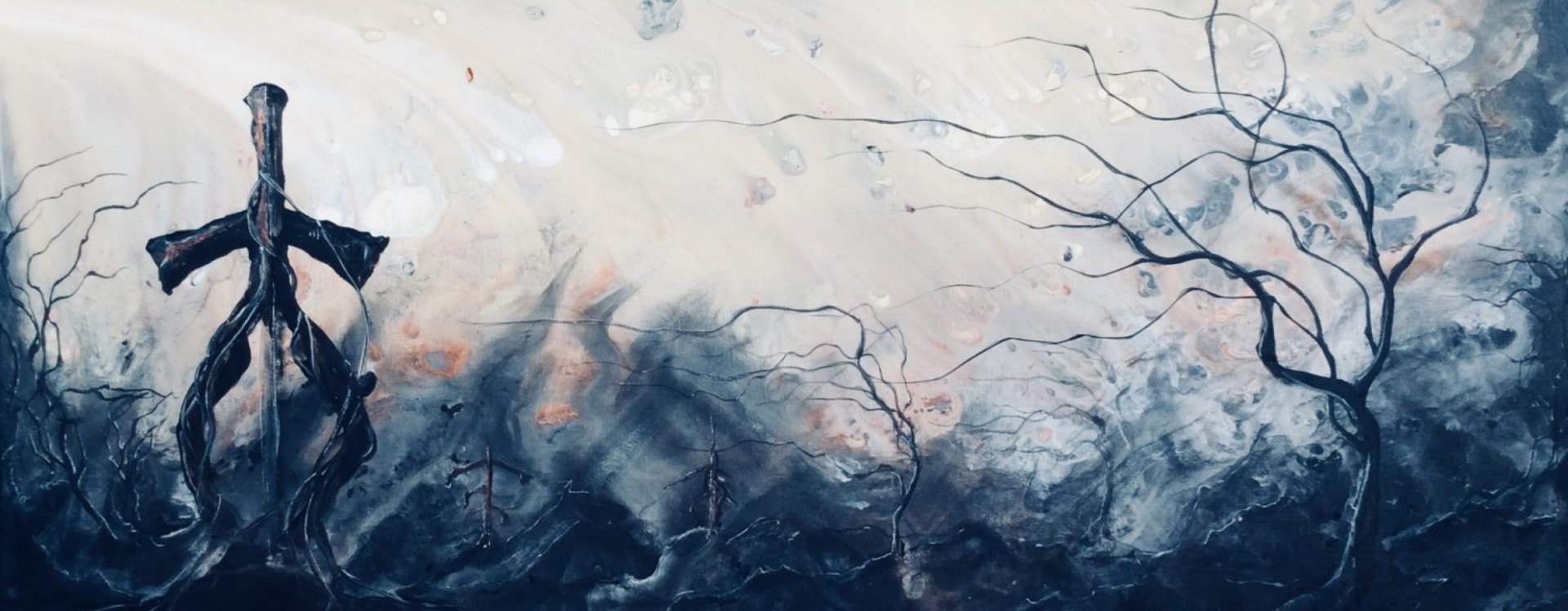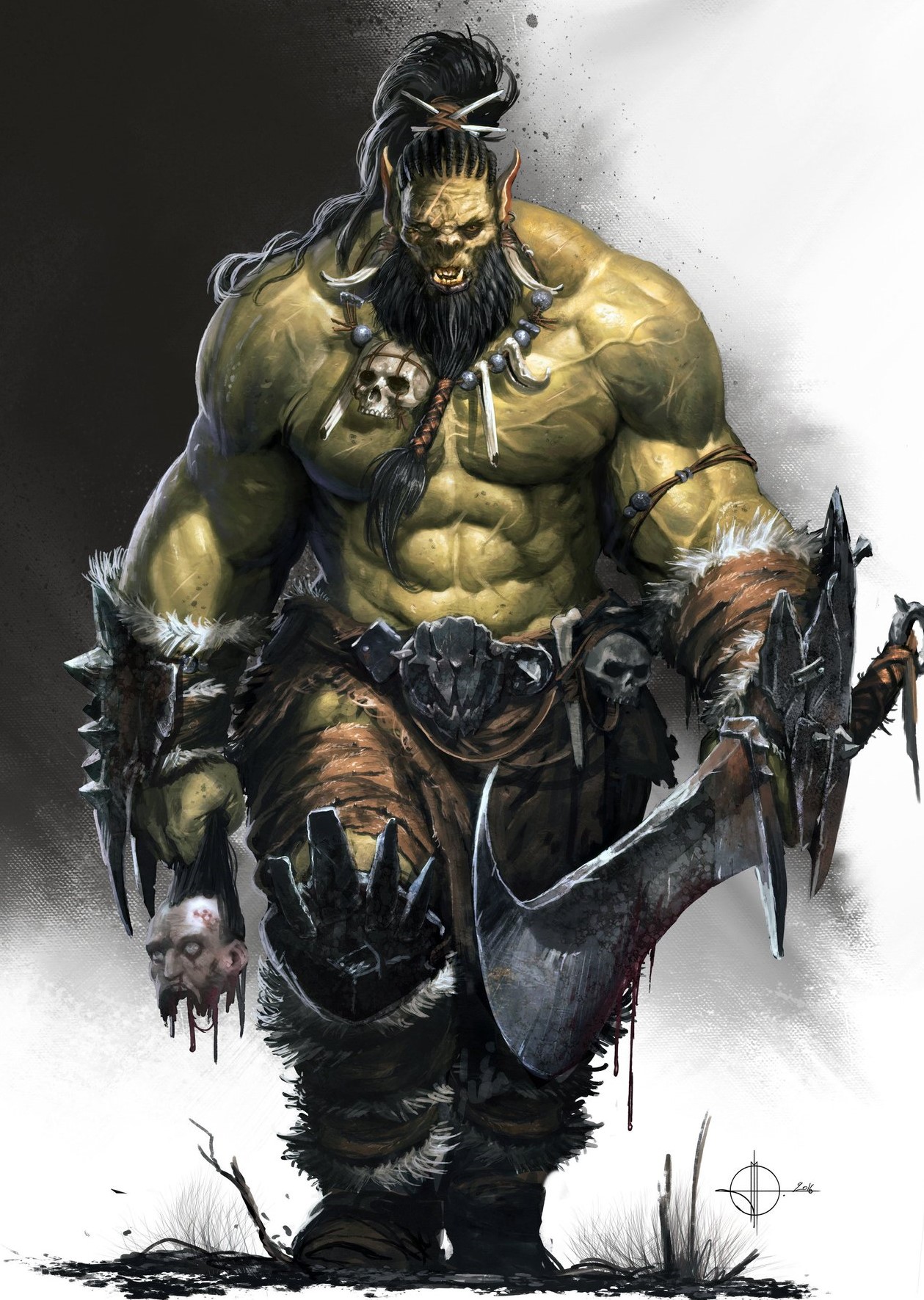Orc
Savage and fearless, orc tribes are ever in search of elves, dwarves, and humans to destroy. Motivated by their hatred of the civilized races of the world and their need to satisfy the demands of their deities, the orcs know that if they fight well and bring glory to their tribe, Gruumsh will call them home to Ereshkigal.
Personality
Orcs survive through savagery and force of numbers. Theirs is a life that has no place for weakness, and every warrior must be strong enough to take what is needed by force. Orcs aren't interested in treaties, trade negotiations or diplomacy. They care only for satisfying their insatiable desire for battle, to smash their foes and appease their god (read Emanation). Orcs live in constant fear of their god, and their behavior is rooted in that mentality. They believe that they can see the influence of Gruumsh everywhere in the world around them, and the priests of a tribe are entrusted with the responsibility of identifying these signs and omens-both good and bad-and deciding how the tribe should react to them. As a race, orcs have no noteworthy universal social traits, but some commonality does exist in the crude written communication that all orcs employ and in the way that they use pigments to decorate and distinguish themselves and their lairs. Orcs appreciate physical prowess and formidable combat ability in any form. As such, they might accept other creatures into their ranks from time to time. Orcs have been known to associate with wereboars and ettins, both creatures that can markedly improve a tribe's murderous efficiency. For a promise of sufficient food and loot, a troll might accompany a tribe temporarily. A group of orcs can be dominated by evil creatures of immense power, and they accept this subservient role either because they are forced to or because it offers them a measure of security while they engage in their savagery. Most orcs have been indoctrinated into a life of destruction and slaughter. But unlike creatures who by their very nature are evil, such as gnolls, it's possible that an orc, if raised outside its culture, could develop a limited capacity for empathy, love, and compassion. No matter how domesticated an orc might seem, its blood lust flows just beneath the surface. With its instinctive love of battle and its desire to prove its strength, an orc trying to live within the confines of civilization is faced with a difficult task.Basic Information
Anatomy
Orcs are tall and powerfully built, with long arms and stocky legs. Some orcs top 7 feet in height, though they tend to adopt broad, almost bow-legged stances and slouch forward at the shoulders. The combination makes for a seeming contradiction, sharing an eye level with most humanoids while simultaneously towering over them. Orcs have rough skin, thick bones, and rock-hard muscles, making them suited to war and other physically demanding tasks. Despite the roughness of their skin, orcs scar easily, and most orcs take great pride in the scars they have accumulated. Orc skin color is typically green and occasionally gray, though some orcs have other skin colors that reflect adaptations to their environments. Their lower jaws jut out and from them protrude large, boar-like tusks. Many also have wolf-like ears that are pointed on the ends, similar to elves.
Orcs consider powerful builds and heavily scarred skin attractive, regardless of gender. A powerful orc makes the hold stronger, and scars are signs of victories won or hardships survived. Similarly, many orcs consider large, jutting tusks to be more attractive than smaller tusks, since the former make more effective weapons. Many orcs also find tattoos to be attractive, particularly large or painful ones that cover a significant amount of skin.
Genetics and Reproduction
In order to replenish the casualties of their endless warring, orcs breed prodigiously (and they aren't choosy about what they breed with, which is why such creatures as half-orcs are found in the world). Females that are about to give birth are relieved of their other roles and taken to the lair's whelping pens.
Growth Rate & Stages
At 4 years old an orc is considered a juvenile, and by age 12 it is a fully functioning adult. Most orcs don't live past the age of 25 due to battle or illness, but an orc can live to about 50, remaining healthy almost up until the end.
Young orcs must mature quickly in order to survive their perilous upbringing. Their early years are fraught with tests of strength, fierce competition and nothing in the way of maternal or paternal love. From the time a child can wield a stick or a crude knife, it asserts itself and defends itself while learning to fight, to survive in the wild, and to fear the gods.
The children that can't endure the rigors of a life of combat are culled from the main body of the tribe, taken into the depths of the lair, and left for better or worse. A fully grown orc warrior is well prepared for a lifetime of combat.
Civilization and Culture
Naming Traditions
Orc names don't always have meaning in the Telgesh language, and most noteworthy orcs are given epithets by their tribe mates.
Orc Male Names: Grutok, Lortar, Abzug, Shugog, Urzul, Ruhk, Mobad, Shamog, Mugrub, Bajok, Rhorog, Jahrukk
Orc Female Names: Kansif, Ownka, Emen, Sutha, Myev, Neega ,Baggi, Shautha, Ovak, 10 Vola, 11 Engong, 12 Volen,
Orc Epithets: The Filthy, Skull Cleaver, Eye Gouger, Iron Tusk, Skin Flayer, Bone Crusher, Flesh Ripper, Doom Hammer, Tiefling Butcher, Spine Snapper, Death Spear, The Brutal
Relationship Ideals
Orcs don't take mates, and no pair-bonding occurs in a tribe other than at the moment when coupling takes place. At other times, males and females are more or less indifferent toward one another. All orcs consider mating to be a mundane necessity of life, and no special significance beyond that is imparted to it.
Culture and Cultural Heritage
When a tribe is on the move, orc warriors are commanded to scour the surrounding landscape for any opportunity to spill blood and bring glory to their gods. Often, bands of warriors work on a rotation, with one group heading out on a raid just as another group returns, laden with severed heads, sacks of loot, and armfuls of food. Warriors also serve as scouts, bringing back detailed reports about the surrounding area so that the chief can plan where to send raiders next.
The territory that orc war parties cover can extend for many miles around the lair, and any encampment or settlement of elves, dwarves, or other soulborn in that area is at risk. If orcs come upon a target that is too large to assault directly, they will lurk along supply routes, taking out their frustration on caravans and travelers. Left unchecked, a tribe can subsist on this sort of prey and booty for quite some time.
Orcs pillage and scavenge wherever they go-everything is loot, and loot is always something to be proud of. In order to haul as much food and booty as possible back to the tribe's den, every tribe has a sturdy war wagon. Since orcs are poor crafters, most of their wagons are stolen from soulborn strongholds, and then decorated with uniquely orcish accessories.
An orc tribe typically has no more than a few hundred members, because a larger group would need a prohibitive amount of resources to remain strong. As a rule, a tribe is violently hostile toward any other tribe it meets, seeing the rival orcs first and foremost as competitors for food and victims.
On some occasions, though, tribes that have a common concern band together. The result is an orc horde-a sea of slavering killers that washes over the countryside and leaves vast tracts of devastation in its wake. Such an event is rare in the extreme, but its consequences can lay low entire nations that are unable to stand against the wave.
Three colors have special meaning to all orcs, and they adorn their bodies, possessions, and lairs with pigments that produce those hues. Red ochre is used to represent blood, grayish-white ash to represent death, and charcoal to represent darkness.
The unwritten laws that govern the status of individual orcs within a tribe are manifested to a degree in how each orc uses these colors on itself and its personal items. For instance, the chief of one tribe might be the only one that has the right to stain its tusks with red ochre, while the warriors of another tribe rub streaks of ash into their garments to signify their safe return from a raid.
Common Customs, Traditions and Rituals
Orcs believe that any seemingly unimportant discovery or event-a bear's claw marks on a tree, a flock of crows, or a sudden gust of wind-might be a communication from Gruumsh.
If the tribe has encountered a similar omen before, the priests understand how to interpret it, but if a sign from the god has no clear explanation, the priests might have to meditate for hours or days to get a vision of its meaning.
Every group of orcs has particular superstitions and recognizes certain omens.
These tenets vary from tribe to tribe, and are often based in events that the tribe has experienced. Here are a few examples:
- If a dwarf or a human invokes its deity upon dying, you must carry the corpse's ears for three days to ward off any retribution, and then bury or burn them.
- Three ravens is always a good sign.
- It is good luck to spit where you are about to sleep.
- Gnome bones can ward off diseases if they are worn.
- Don't stand inside a ring of stones, mushrooms, or any other kind of circle.
- Seeing a shooting star before a battle is bad luck. To ward it off, you must swallow a stone.
- A tribute of tiefling ears brings favor from Gruumsh.
- If you bury five stones at dawn before a long journey, you will always find your way back to the war hearth.
- Stomping your foot three times and uttering "Gruumsh" wards off bad magic.
Interspecies Relations and Assumptions
When orcs attack a settlement of aasimar or halflings, they will kill anyone who presents a threat, but they are more interested in grabbing plunder and food rather than in wanton slaughter. The elderly, children, and any who seem weak or meek enough might escape death. If they leave the population more or less intact, the orcs leave themselves the option of returning to raid the community over and over.
When orcs fight tiefling, all of that changes. The enmity between the two races cuts to the core, and no orc will leave a tiefling alive. Orcs become so frenzied in combat against them that they forget all about taking loot and valuables back to the tribe-the only trophies of any worth are the heads of their enemies.
Orcs treat dwarves somewhat differently from other foes, because they covet the homes that dwarves fashion for themselves. If a tribe succeeds in fighting its way into a dwarfhold, the orcs will butcher any dwarf that stands against them, but it's really all about the property-they would be just as happy if all the dwarves ran away.
Origin/Ancestry
Magog, the Throne of Sin
Lifespan
50 years
Average Height
6'2
Average Weight
215 lbs.
Racial Stats
Orc
Orc
Ability Score Increase +2 Str, +1 Con
Size Medium
Speed 30ft



Comments